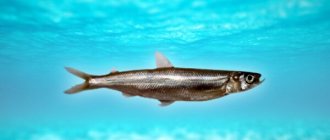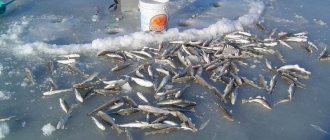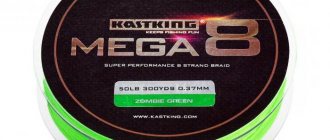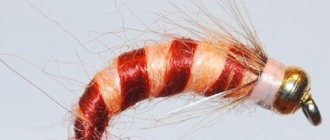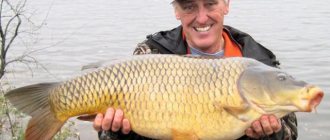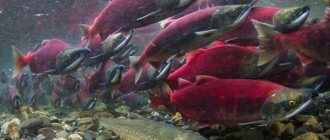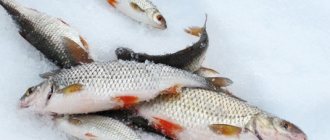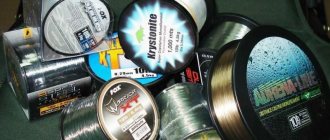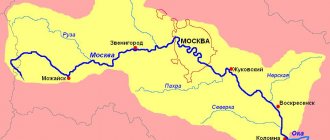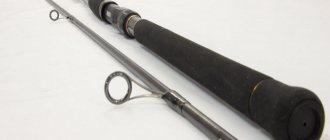Where to catch smelt in winter
This small fish prefers to gather in large, numerous schools, the mass of which can reach a ton. Moreover, there may be several such flocks. It is difficult to even imagine what density of fish is in a certain area of the reservoir.
To determine the location of a school of smelt, just look at the surface of a reservoir covered with ice. Where there is the greatest concentration of fishermen, there is a school of fish. At the same time, the density of fishermen is also amazing: there can be thousands of them per square kilometer. Despite this, each of them will be able to catch several kilograms of fish. This suggests that there are several large schools of smelt in the immediate vicinity of fishermen.
Smelt prefers to be in places where small rivers flow into large ones. This is due to the fact that it will go to small rivers to spawn. Therefore, river mouths are its favorite stopping place. While in this place, she prepares to go to spawn.
Sometimes smelt are caught from a depth of about 20 meters; on rivers with shallower depths, they bite at a depth of 4 to 8 meters. This fish prefers places with a flat bottom, unlike other types of fish that go to pits with significant depths for the winter.
It is caught between the bottom and up to 1 meter away from the bottom. The bait is played by raising it to a height of 1 meter and lowering it to the bottom. It is on this horizon that the bites occur. Although there are cases when smelt accumulates at other depths. In this case, a lot depends on weather conditions.
Fishing rod
Typically, foam fishing rods shaped like a “filly” are used to catch smelt. The total length of such a fishing rod is from 10 to 20 cm, and practice shows that the longer the reel on it, the faster the unwinding and winding of the fishing line is carried out, and the twisting of the latter is reduced. The main requirements for a fishing rod are that it cannot be sunk, even if there is a weighty trophy, and that it clings to uneven ice as little as possible.
This is the classic option, but there are others. The most common is the rod and reel. It is convenient when searching for fish (the tackle is wound up and unwound faster), but is usually made from non-buoyant materials, so it is often lost during the fishing process: simply put, if you hesitate, you will drown.
One of the interesting options is a fishing rod that does not have a nod, and the rod itself signals the bite. The fishing rod is inserted into a special mount, in which it balances until it bites. True, it is almost impossible to fish with such a fishing rod in the current.
All these fishing rods can be made by the fishermen themselves, so the sizes and shapes are limited only by their experience and imagination. I outlined the most, in my opinion, fundamentally interesting models.
When to catch smelt in winter
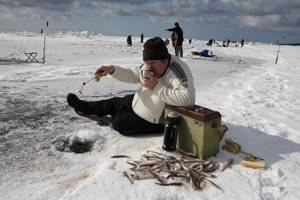
Paradoxically, you can catch smelt around the clock, both day and night. Most anglers prefer to catch this fish during the day, although there are some that stay overnight. They stock up on everything they need in advance and continue to catch it. The most basic device is a gasoline-powered generator that generates electricity. At the same time, it should be noted that with the onset of darkness, smelt becomes more active.
Throughout the fishing, especially during the day, the bite of this fish is more stable, although it can either intensify or weaken. This is due to the fact that the school of smelt is in constant motion. The activity of the fish also depends on the density of the school. Sometimes there are cases when the bite stops due to the departure of a large flock to a small distance. After some time, the fish may return and start pecking just as actively.
At night, the smelt becomes active, plus it is attracted to a beam of light directed into the water. This factor further increases the bite activity, which is what fishermen take advantage of.
If you look at the river at night, you can confuse it with the central avenue of the city, illuminated by numerous light sources.
Tackle assembly
Now let's talk about the gear itself in general. Usually 2-3 jigs are placed. The first jig is tied 8-10 cm from the load, the second - 30-35 cm, the rest - higher, at an arbitrary distance. It makes sense to use the so-called “whatnot” - this is a fishing rod on which the jigs are located up to 6-8 cm from the load. It is not uncommon for fish to pass through the upper layers; True, there is not very much of it, but with a generally good bite, this makeweight is still significant. On the “whatnot”, up to 8-10 jigs are used, tied every 1-1.5 m. I use one fishing rod equipped in this way. You also need to have spare jigs with leashes, and if there are bites on the “whatnot”, you need to tie them to ordinary fishing rods at the level where the bites occurred.
The jigs themselves are tied to the main fishing line on 2-3 cm leashes, this length allows them not to twist around the fishing line. 30-33 m of fishing line should be wound on the fishing rod, i.e. Divide a 100-meter reel into 3 parts. Personally, I had to fish at a depth of up to 31 m, so you shouldn’t skimp on this.
When the bite is mediocre, I use 7-8 fishing rods, some anglers use more, some less, but for me this is the most optimal number. With a good bite, I reduce their number to 2-4, or rather, to such a number that I can cope with. At a depth of 30 m, even with a very good bite, the use of 3-4 fishing rods is quite justified, unless, of course, the fishing line clings to the ice and the load itself drags it into the hole. Also, a smaller number of fishing rods allows you to change the bait more often and light up the jigs, and this significantly increases the number of bites.
Tackle, bait and lures
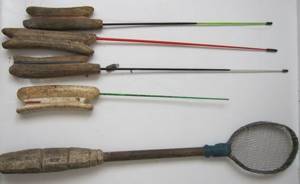
Considering the fact that smelt is a small fish and cannot break the tackle, even if you use a fishing line of minimal thickness, fishermen take advantage of this feature. If you take a thick fishing line, this will negatively affect the fishing process. A thick fishing line can alert smelt. The most optimal fishing line diameter is from 0.15 mm to 0.2 mm. There are also minimum requirements for a winter fishing rod. The main thing is that it is comfortable and has a sensitive nod to respond to very subtle bites of a small fish. Barely noticeable bites require concentration and a certain skill.
Jigs with a diameter of 4 to 6 mm are suitable as bait. If you take jigs of a larger diameter, the number of bites will sharply decrease, although larger individuals will be caught. When using a 4 mm jig, the number of bites may be maximum.
More experienced anglers use phosphorus jigs, which increases the number of bites if the fish is inactive. At the same time, during the pre-spawning feeding period, it is able to peck on a bare hook. During this period, she doesn’t particularly bother with baits and doesn’t care what material they are made of.
To increase the efficiency of the tackle, another hook can be tied to the fishing line, on a leash 10 cm long. The distance from the jig to the hook can be 20-30 cm. As practice shows, this approach allows you to fish a large area. At the same time, the hook additionally attracts smelt with its movements in the current. When smelt is very active, the tackle is capable of catching 2 individuals at once.
Additional baits can be attached to jigs, such as:
- maggot;
- bloodworm;
- worm;
- piece of fish.
These are generally the most common baits used by fishermen when fishing for smelt. Sometimes, to activate the bite, pieces of the smelt itself are used if there is nothing suitable at hand. Smelt, although a small fish, can safely be classified as a predatory fish species. This can be evidenced by the smelt's mouth, strewn with small but sharp teeth. Therefore, the use of bait of animal origin should be a priority.
Winter gear for smelt
Smelt fishing rod and equipment
The choice of fishing rod for smelt is of great importance for many reasons. Since winter smelt fishing requires high activity from the fisherman, you have to fish with several fishing rods at once and at great depths, and sometimes you have to quickly change the place if there is no bite. That is, collect all the gear, quickly move to another place, and reinstall all the fishing rods. Therefore, smelt fishing rods must have the ability to quickly reel in fishing line and the ability to quickly attach hooks. And also the specificity of winter fishing for smelt is that when biting, you need to sharply hook the fishing rod and throw it onto the ice, and then pull the line out with your hands. And the smelt fishing rod must withstand such repeated falls and not break.

Usually, when fishing for smelt, each fisherman has several fishing rods, many even arrange too many fishing rods, 15-20 pieces each. But realistically, it is enough to have 5-10 fishing rods with you for smelt, and it is better to place no more than 8 fishing rods, since it is inconvenient to maintain, change bait and light jigs for smelt with more than 8 fishing rods. And 1-2 fishing rods remain in reserve in case the main fishing rods get tangled, and this happens quite often, and in the cold and wind it is easier to get a reserve fishing rod than to untangle the beard on the fishing line. And be sure to have a trolling rod with you, equipped with a smelt lure. Sometimes smelt are caught very successfully using a spoon.
There is another restriction on the number of fishing rods for catching smelt, which in the fishing rules entails a financial fine. There should be no more than 10 hooks or jigs per fisherman. In winter, the number of hooks in smelt gear placed at the holes can be counted right on the ice by a fishery control and supervision inspector who suddenly appears and issues a fine if the rules are violated. Such situations have already begun to occur in the Gulf of Finland during winter smelt fishing. But so far such inspections are not very frequent.
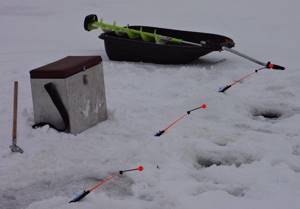
So, based on the above requirements, the smelt fishing rod must be durable and equipped with a reel for fishing line, and the fishing rod must float if it falls into the hole. Based on the experience of catching smelt, the best smelt fishing rod was one made by hand from finely porous and durable foam, which has a yellowish tint. Such foam was usually used for large floats in commercial fishing nets; such floats could be found on the shore of the bay, washed up by a storm.
Oblong bars are cut from polystyrene foam, with dimensions of 15-18 cm in length, 3.5-4.5 cm in width and 2.0-3.0 cm in thickness. You need such bars for fishing rods so that the fishing rod can be conveniently taken even in a mitten. A whip is glued into the block, and a simple and small coil of caprolon is tied to the block with electrical tape. Now such a reel and such foam can be bought on the fishing market, but the price is much higher than for ordinary Chinese fishing rods with a reel.
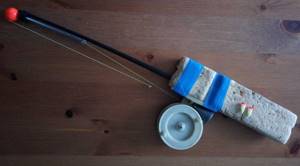
If it’s difficult to make a fishing rod for smelt yourself, then you shouldn’t buy the cheapest one, now there are a lot of poor quality winter fishing rods on sale, and you can still choose a shock-resistant and comfortable fishing rod. If the fishing rod is made of plastic, then it should be frost-resistant, the plastic should not break in the cold, and you should also not take a fishing rod made of white foam, as it is very fragile and breaks instantly with a slight impact or stress. The reel must also withstand falls on ice and frosty weather.
The whip on a smelt fishing rod is also very important and sometimes breaks when hooking, especially in the cold. When choosing a whip for a fishing rod, you will have to experiment, try different ones to find one that is durable and flexible. There are many different whips sold in fishing stores, and you can’t immediately tell by their appearance how high quality they are, so there is one way: take a whip with you fishing and try it on a couple of fishing rods; if the tests are successful, then you can equip all your smelt fishing rods with these with whips. If the whip is too long, then it can be trimmed; a length of 20-25 cm is sufficient, taking into account the fact that a 3-4 cm part of the whip will be inserted into the fishing rod.

To rig a fishing rod for smelt in winter, you definitely need a nod on the whip. For smelt fishing, it is better to use a spring nod with a red ball at the tip. This nod is not expensive, easy to use and quite durable. The basic requirements for a spring nod, a spring in terms of its elasticity is needed with average indicators; you should not take it too elastic or too flexible. The nod must be able to be adjusted in length, and most importantly, the red ball at the tip of the nod must be small, 1.0-1.5 cm in diameter. A ball that is too large will sway in the wind and create the appearance of a bite.
A spring nod has one drawback: if there is a random knot on the main line, somewhere in the middle, then in cold weather when winding the line, the knot will get stuck in the tip of the nod and then you will have to warm up the tip of the nod a little or pick something there. When it’s cold, ice freezes precisely at the tip of the nod in the ball, for the reason that when there is an active smelt bite, sometimes the fishing rod dives into the water or, when you have to reel in the fishing rod or reel in, the water from the fishing line remains in the tips and freezes there and the knots no longer fit through. Therefore, it is better that there are no knots on the main line, and they are not needed there.
Fishing technique
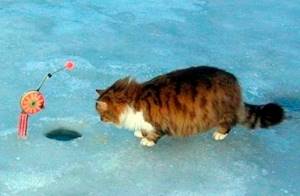
First you need to find a school of smelt and only then start catching it. If this fish is actively biting, then it makes no sense to install two or more fishing rods, since it will be quite difficult to cope with even one fishing rod. If bites follow one after another, then it’s not at all difficult to forget about other fishing rods. If the bite is weak, you can use more than one fishing rod. The number of installed fishing rods is determined experimentally. The main thing is to be able to check and install each fishing rod, otherwise fishing will turn from pleasure into a nightmare.
Since smelt fishing is carried out on the river, it is very important that the gear does not get tangled with one another. Based on this condition, we can immediately say that holes need to be drilled perpendicular to the flow. This approach will minimize the likelihood of gear overlaps. It is very important that all anglers adhere to this technology, especially in conditions of such density.
Smelt are caught both on fixed baits and on baits that are given a certain action. It all depends on the activity of the fish. If smelt actively takes bait, then it can also take permanently installed gear. If she refuses to bite just like that, then she has to be attracted by a certain game of the jig. The fisherman’s task is to make the hook in time, since the smelt bites are barely noticeable and barely sensitive.
The bait game begins from the lowest point, although it is possible that this point may be much higher. This point can be the bottom of the reservoir. At the same time, the jig rises to a height of about 1 meter. After which there is a pause and the bait sinks to the bottom again. Bites occur when the bait rises and are characterized by a barely noticeable push. It is very important to learn to determine the moments of bites, otherwise smelt gatherings cannot be avoided.
Fishing methods
The choice of method for catching smelt from ice can be influenced by weather conditions, angler preference, and fish activity. Despite the fairly high biting activity, in some periods the smelt may refuse the offered bait and the fisherman has to adapt to its preferences. Smelt is mainly caught by fishing with a tyrant, a nodding rod and a float.
Fishing with a tyrant
Samodur is a very simple and popular equipment for catching smelt. It shows itself especially well in the first half of winter, especially after freeze-up, when the pre-spawning feast forces the predatory smelt to rush to almost any bait.
It is very easy to make this equipment:
• Take a piece of lead line 1.5-2 meters long. The size of the segment can vary and depends on what horizons the angler wants to fish. • A weight is tied to the end of the fishing line. • Above the sinker, at a distance of 10 cm, a short leash with a hook is tied. Next, several more hooks are knitted at an equal distance from each other. They need to be tied so that their stings point up in the water. • All equipment is tied to the main line.
The number of hooks may vary and range from 3 to 15 pieces. Since smelt can occupy not only the bottom layers, and a large number of hooks allows you to find fish at different depths. At the same time, the more hooks, the more difficult it is to handle the tackle and the likelihood of entanglement increases significantly. With a good bite, three hooks are enough.
The hook size is usually small - No. 2.5-3.5 according to the domestic size chart. But often anglers use larger hooks, especially if there is a large fish. The diameter of the main line ranges from 0.12-0.16 mm, for leashes - 0.08-0.10 mm. The tyrant rig is tied to the main fishing line. Fishing takes place with a regular nodless winter fishing rod.
Operating principle and features of use:
• Pieces of colored latex (green, red) 4-6 mm in size are used as bait or hooks are tied with multi-colored threads or hairs. Special latex strips can be bought at a fishing store, but quite often fishermen cut pieces of the desired size from a regular condom. • The equipment is immersed in the hole until the weight touches the bottom. He should pull the line, holding it in one place. • Fishing is passive, but if the bite is bad, you can periodically twitch the tackle. They set up several fishing rods at the same time, going around them one by one and checking for the presence of prey. • If the fish activity is weak, you can loosen the line somewhat so that the hooks oscillate more freely in the water, more strongly attracting predatory smelt.
Fishing with artificial bait
Like any predator, smelt can be successfully caught using artificial bait - a jig or a spinner. For this use:
• a fishing rod with a metal spring nod; • main line with a diameter of 0.15-0.20 mm. In some cases, a thicker monofilament is used - 0.25-0.30 mm; • small jigs made of tungsten for quick immersion to the bottom. The color is light, preferably with a phosphorescent coating - smelt fishing takes place at great depths and the bait should be more noticeable; • from spinners choose small models, 1-2 centimeters long. The color is golden or silver.
Fishing with jigs and spinners is the same - bait is placed on the hook and the tackle is lowered into the hole. Fishing can be done with either a standing or moving bait. The game is simple - raising and lowering the tackle with pauses. Some anglers fish in two holes at once, holding a fishing rod in each hand.
When fishing with a standing bait, a bite is signaled by the upward movement of the nod. You should fish quickly, as the smelt resists quite actively on the hook.
The bait can be animal or, as when fishing with a tyrant, colored latex or thread.
Fishing with a float
Fishing with a float rod is, of course, passive, but at certain moments it is much more effective than with a nodding rod. It manifests itself especially well during periods of low smelt activity.
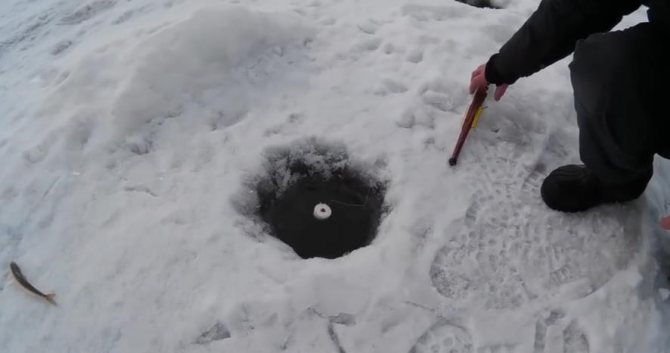
The gear is almost the same as when fishing with a jig, with a slight difference: • a fishing rod without a nod - the float signals a bite; • light small float; • jig or hook depending on the equipment option; • if necessary, a leash with a thickness of 0.10 mm.
When fishing with a float, you can use either a jig or a regular hook. In the first case, the jig also serves as a weight. If the weight of the bait is not enough (for example, when fishing in a current), then a weight is attached to the end of the fishing line, and hooks are tied a few centimeters higher on short leashes. It is not uncommon to use more than one hook.
In warm and calm weather, the float can be loaded flush with the surface of the water, but basically it should be submerged. To do this, additional pellet weights are hung.
Fishing on a float uses only live bait, which significantly increases the chances of catching when the fish are sluggish. This method is associated with certain difficulties - you will have to change bait quite often, which is not very convenient to do in the cold with unprotected hands.
Winter fishing for smelt using makhalka
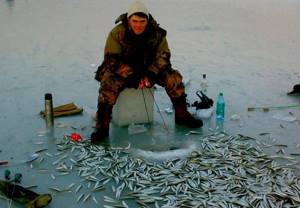
The use of spinners speeds up the process of catching smelt and makes it more interesting. Special small spoons with a diameter of about 5 mm are used as bait. As an option, ordinary hooks with a slight load, as well as additional attributes in the form of feathers, are used. This bait is somewhat similar to flies for fly fishing. Such spinners have hooks that do not have a barb, which does not allow the fish to leave the hook.
As a rule, this notch is ground off or appropriate hooks are purchased. This is necessary so as not to waste time freeing the fish from the hook. She does it herself when she gets on the ice. This increases the number of fish caught, and the movements are practiced until they become automatic.
Swing tackles are equipped with long (about 0.5 meters) rods, both homemade and purchased. Mahalki are used when fishing for smelt at shallow depths or in the upper layers of water. In any case, this is a fairly effective tackle, distinguished by its simplicity. The only thing that is required from the fisherman is patience and perseverance, as well as a sufficient amount of energy. Not every angler is able to withstand such a high pace of catching this small but tasty fish.
Tips for catching smelt
Below are some basic tips and tricks to help you increase your smelt catch:
- Finding the habitat of smelt is not difficult; this breed prefers to stay near desalinated bays and estuaries, and river mouths. Here the fish are present before spawning and often remain for the winter.
- When fishing with spoons, you can use a spinning rod as a tackle; vertical casts made from a boat are most effective.
- Fishing for caught prey should be done quickly, but unnecessary sudden movements that can lead to the escape of the fish should be avoided.
- The fisherman will need to develop a good reaction, since smelt has a fast bite that requires timely hooking.
- After hooking, you need to immediately remove the prey from the water; during the fishing process, a long fishing line can be wound around your hand to prevent it from getting tangled.
- Smelt is a schooling fish, prone to constant migrations, so it is necessary to move after the schools: an area where the bite has been stable for several days can quickly lose its prospects.
- When ice fishing for smelt using several tackles, the holes should be located on the same straight line and be perpendicular to the direction of the current, otherwise the fishing line will often get tangled.
- Smelt is an unpretentious fish; it can be caught in any weather: precipitation or changes in pressure do not affect its behavior in any way.
Let's celebrate! When fishing, it is always recommended to have several spare gear with you in case of unforeseen circumstances, especially if fishing is carried out in winter, when a lot of effort and time is spent on preparing the place.
Where to fish
In the city on the Neva, smelt fishing has always been very popular, and although you can’t count on big trophies at the moment, it’s still a very exciting and interesting type of fishing, and there’s nothing to say about the excellent culinary qualities of smelt... One of the most fish reservoirs where it is successfully mined - the Gulf of Finland. Here, smelt can be caught almost along the entire coast - from the dam to those places you can get to.
The main criteria in choosing a fishing spot are the number of fish present there, its size, the ability to get there and the ice conditions. Unfortunately, these criteria do not always coincide. Those who go fishing as a vacation from family or work, and do not strive for huge catches, fish not far from St. Petersburg in the water area from the Resort to Privetninskoye, where there are few fish (except for the period of last ice), the ice situation is calm, and transport walks quite regularly.
Those who expect to catch smelt properly try to go as far as possible, often to places with poor ice conditions, for which the southern coast of the bay (Krasnaya Gorka, Krasnoflotsk) is especially famous. And on the northern coast - due to the opening of the port in Primorsk and the ice-free fairway - there are practically no safe places. But, alas, it is open water that attracts smelt, and if the ice is within 1-1.5 hours of travel, that’s where you need to look for it (however, this advice is more likely for those who do not value life).
